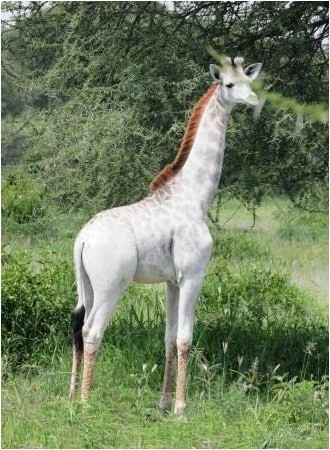By Ana Verayo, | January 27, 2016

Meet Omo, the white giraffe of Tanzania.
An extremely rare, white giraffe was spotted in the Tarangire National Park in Tanzania, which was first spotted last year and is now photographed again.
Like Us on Facebook
According to the Wild Nature Institute, this special giraffe was named "Omo" after a famous brand of detergent among locals in the region. Omo is also the only second record of white giraffe in Tarangire in more than 20 years, among 3,000 giraffes in the area, making it very rare, says principal scientist Derek Lee.
Researchers and wildlife officials from the Wild Nature Institute reveals that Omo possesses this unusual, pale coloration across her body since her surface cells cannot produce any pigment although scientists note she is not an albino. Scientists reveal that Omo is leucistic, meaning, that some or all of her pigment cells were unable to develop fully.
The Institute explained on their blog how to spot the difference between albino and leucistic animals, where albino animals lack melanin all over their body including their eyes, which leaves them with reddish eyes due to the color of their blood vessels. Omo apparently does not have red eyes.
Lee explains that this second sighting of the white giraffe made the members and staff of the Institute happy as she is alive and well since giraffes are often targeted by lions, leopards and hyenas during their first year. It is also illegal to kill a giraffe in Tanzania since it is the national animal, however, there is a black market for its meat that is rampant around Tarangire.
Giraffes in Tanzania are targeted for bushmeat poaching and since Omo lives inside a national park, her chances for survival are higher since the area have stricter anti-poaching regulations.
The staff hopes to raise global awareness for giraffes especially since Omo is getting new media attention. To date, giraffe populations across Africa are now declining due to habitat loss and meat hunting. Giraffes are now a threatened species, where there is one giraffe for every four elephants in Africa today, says Lee.
The Institute is now studying giraffes that are living in mixed human and natural systems, which is the majority of their remaining habitats. Protected areas with fragmented giraffe populations such as the Tarangire are pivotal for the survival of these creatures, where these can also be applied in the future, throughout the rest of Africa.
-
Use of Coronavirus Pandemic Drones Raises Privacy Concerns: Drones Spread Fear, Local Officials Say

-
Coronavirus Hampers The Delivery Of Lockheed Martin F-35 Stealth Fighters For 2020

-
Instagram Speeds Up Plans to Add Account Memorialization Feature Due to COVID-19 Deaths

-
NASA: Perseverance Plans to Bring 'Mars Rock' to Earth in 2031

-
600 Dead And 3,000 In The Hospital as Iranians Believed Drinking High-Concentrations of Alcohol Can Cure The Coronavirus

-
600 Dead And 3,000 In The Hospital as Iranians Believed Drinking High-Concentrations of Alcohol Can Cure The Coronavirus

-
COVID-19: Doctors, Nurses Use Virtual Reality to Learn New Skills in Treating Coronavirus Patients







